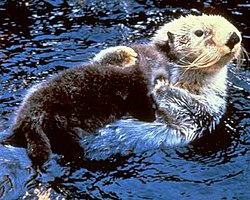otter
| otter | ||||||||||||
|---|---|---|---|---|---|---|---|---|---|---|---|---|

River otter ( lutra lutra ) |
||||||||||||
| Systematics | ||||||||||||
|
||||||||||||
| Scientific name | ||||||||||||
| Lutrinae | ||||||||||||
| Bonaparte , 1838 | ||||||||||||
| Genera | ||||||||||||
|
The Otter (Lutrinae) - even water Marder called - are an amphibious living subfamily of Marten (Mustelidae). There are thirteen species in seven genera .
features
All members of this subfamily have an elongated body, short webbed legs, a long, powerful tail and a round head with a blunt snout. The otters are the largest members of this family ( giant otters and sea otters ) with a length of about one meter and 22 to 45 kg . As with all martens, the males are about a quarter larger than the females. Their fur is uniformly brown-gray, sometimes slightly speckled and often a little lighter on the "collar" and / or on the stomach. With more than 1000 hairs per square millimeter, they have one of the densest skins in the animal kingdom. Due to the structure of the fur - long fur protects the thick, soft undercoat - you can keep an insulating layer of air around your body even when you stay in the water for a long time. They can close their tiny ears and nostrils when they are in the water.
distribution and habitat
Otters are found almost all over the world, they are only missing in Australia and on remote islands. They mainly live by the water. They are excellent swimmers and divers and have populated all sorts of inland waterways and even rocky sea coasts. They are usually never found more than 500 meters from water. Sometimes they hide in abandoned buildings of other animals or under stones, but at least have a permanent structure out of the water. The entrance can be under water, but the structure itself is always above the water line. Some species even create several chambers.
Otters live territorially. The territory of a male is usually larger than that of the females, but can overlap with their territory. Conspecifics of the same sex are mostly expelled.
Way of life

Otters swim by moving their hind legs and tail. You can stay underwater for up to eight minutes. On land, they often move in a combination of running and sledding. Although they prefer water as their habitat, they can, if necessary, cover longer distances over land, for example when they have to look for ice-free water in winter. On land they can reach speeds of up to 29 km / h . Otters can be diurnal or nocturnal , but mostly they are more nocturnal.
Like the rest of their family, otters are predators. They usually get their food from the water; it is made up of fish , frogs , crabs and other invertebrates . Otters have a very high metabolism - for example, the otter has to eat 15 percent of its body weight per day, a sea otter as much as 20 to 25 percent, depending on the water temperature. In 10 ° C cold water they have to catch around 100 grams of fish per hour in order to survive. Most species hunt three to five hours a day, lactating females up to eight hours.
Otters have well-developed anal glands . They mark the boundaries of their territory and so probably “communicate” to strength and willingness to mate ( oestrus ). While the males usually live solitary, the females often form a family group with their young until the next pregnancy. Mating usually takes place in late winter or early spring and the birth of one to five cubs from April to May. The boys weigh about 130 grams at birth and open their eyes after about a month. They start swimming lessons around two months old. They leave their mother when they are around one year old and are sexually mature when they are two to three years old.
Danger
As a group, otters suffer from habitat destruction, water pollution , increased levels of insecticides , hunting and overfishing . In addition, they are still seen as food competitors of humans and - often despite the prohibition - hunted.
Systematics
The otters are divided into seven genera with a total of thirteen species.
- The tribe Lutrini is composed of ten species:
- The old world otter ( Lutra ) comprise three species, including the Eurasian otter , which also lives in Europe .
- The blotched-neck otter ( Hydrictis maculicollis )
- The Indian otter ( Lutrogale perspicillata ) is closely related to the old world otters.
- The New World Otters ( Lontra ) comprise four species living in America.
- The giant otter ( Pteronura brasiliensis ) lives in South America and is one of the largest otters.
- The animals of the Aonychini tribe are characterized by regressed claws and webbed feet :
- The finger otters ( Aonyx ) consist of two species that live in Africa and Asia.
- The tribe Enhydrini includes only one species:
- The sea otter ( Enhydra lutris ) is best adapted to a marine lifestyle.
See also
literature
- Ronald M. Nowak: Walker's Mammals of the World . 6th edition. Johns Hopkins University Press, Baltimore 1999, ISBN 0-8018-5789-9 (English).
Web links
Single receipts
- ↑ Otter - Spectrum of Science ( Spectrum Academic Publishing House , Heidelberg, 1999)

